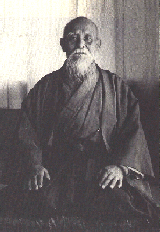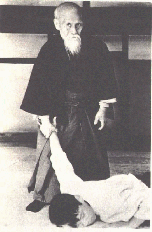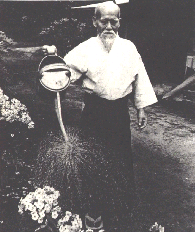|
|

|
"Those who are skilled in combat do not become angered, those who
are skilled at winning do not become afraid. Thus the wise win before
the fight, while the ignorant fight to win."

|
|
The Principles of Aikido
Aikido is a Japanese martial art developed by Ueshiba Morihei. On a
purely physical level it is an art involving some throws and joint
locks that are derived from jiu-jitsu and some throws and other
techniques derived from kenjutsu. Aikido focuses not on punching or
kicking opponents, but rather on using their own energy to gain
control of them or to throw them away from you. It is not a static
art, but places great emphasis on motion and the dynamics of movement.
Upon closer examination, practitioners will find from Aikido what they
are looking for, whether it is applicable self-defence technique,
spiritual enlightenment, physical health or peace of mind. O-Sensei
emphasised the moral and spiritual aspects of this art, placing great
weight on the development of harmony and peace. "The Way of Harmony of
the Spirit" is one way that "Aikido" may be translated into English.
This is still true of Aikido today, although different styles emphasise
the more spiritual aspects to greater or lesser degrees. Although the
idea of a martial discipline striving for peace and harmony may seem
paradoxical, it is the most basic tenet of the art.
We could attempt to further define Aikido, but we would not do it
justice, so we leave the practitioner of Aikido to find out what
Aikido is for themselves without any preconceived notions.
The benefits of Aikido
Aikido practise can benefit everyone, male or female, young or old,
of any ethnic or national origin. All can enjoy and improve their
health and fitness by attending regular and well run classes.
The formal and more cerebral aspect of our system appeal to certain
students. Its full and natural body movement has aerobic benefits for
all. When practised regularly it will assist in developing a fitter,
more supple and stronger body with improved flexibility, reflexes and
reactions.
Aikido is essentially non-violent, encourages harmony and avoidance
of confrontation. Force is never opposed by force. Resolving a
conflict quiescently is better for all concerned and students soon
learn how to improve their self-awareness, and with the techniques
learnt, also grow in self-confidence. In this Aikido teaches
self-defence. Aikido is today's fastest growing recreational activity
with Japanese origins that go back many centuries. Aikido as practised
today includes joint locking techniques and body movements from many
of the ancient fighting methods taught, used, and perfected by the
Samurai in feudal Japan.
|

|
|
 Aikido's founder, Morihei Ueshiba, (or "O-Sensei" which means "Great Teacher") was born in Japan on December 14, 1883.
As a boy, he often saw local thugs beat up his father for political
reasons. He set out to make himself strong so that he could take revenge.
He devoted himself to hard physical conditioning and eventually to the
practice of martial arts, receiving certificates of mastery in several
styles of jujitsu, fencing, and spear fighting. In spite of his impressive
physical and martial capabilities, however, he felt very dissatisfied. He
began delving into religions in hopes of finding a deeper significance to
life, all the while continuing to pursue his studies of budo, or the
martial arts. By combining his martial training with his religious and
political ideologies, he created the modern martial art of aikido.
Aikido's founder, Morihei Ueshiba, (or "O-Sensei" which means "Great Teacher") was born in Japan on December 14, 1883.
As a boy, he often saw local thugs beat up his father for political
reasons. He set out to make himself strong so that he could take revenge.
He devoted himself to hard physical conditioning and eventually to the
practice of martial arts, receiving certificates of mastery in several
styles of jujitsu, fencing, and spear fighting. In spite of his impressive
physical and martial capabilities, however, he felt very dissatisfied. He
began delving into religions in hopes of finding a deeper significance to
life, all the while continuing to pursue his studies of budo, or the
martial arts. By combining his martial training with his religious and
political ideologies, he created the modern martial art of aikido.
 Ueshiba decided on the name "aikido" in 1942 (before that he called his
martial art "aikibudo" and "aikinomichi"). On the technical side, aikido is rooted in
several styles of jujitsu (from which modern judo is also derived), in
particular daitoryu (aiki)jujitsu, as well as sword and spear fighting
arts. Oversimplifying somewhat, we may say that aikido takes the joint
locks and throws from jujitsu and combines them with the body movements of
sword and spear fighting. However, we must also realize that many aikido
techniques are the result of Master Ueshiba's own innovation.
Ueshiba decided on the name "aikido" in 1942 (before that he called his
martial art "aikibudo" and "aikinomichi"). On the technical side, aikido is rooted in
several styles of jujitsu (from which modern judo is also derived), in
particular daitoryu (aiki)jujitsu, as well as sword and spear fighting
arts. Oversimplifying somewhat, we may say that aikido takes the joint
locks and throws from jujitsu and combines them with the body movements of
sword and spear fighting. However, we must also realize that many aikido
techniques are the result of Master Ueshiba's own innovation.
 On the religious side, O-Sensei was a devotee of one of Japan's so-called "new
religions," Omotokyo. Omotokyo is part neo-shintoism and part
socio-political idealism. One goal of omotokyo has been the unification of
all humanity in a single "heavenly kingdom on earth" where all religions
would be united under the banner of omotokyo. It is impossible sufficiently
to understand many of O-sensei's writings and sayings without keeping the
influence of Omotokyo firmly in mind. Despite what many people think or
claim, there is no unified philosophy of aikido. What there is, instead, is
a disorganized and only partially coherent collection of religious,
ethical, and metaphysical beliefs which are only more or less shared by
aikidoists, and which are either transmitted by word of mouth or found in
scattered publications about aikido.
On the religious side, O-Sensei was a devotee of one of Japan's so-called "new
religions," Omotokyo. Omotokyo is part neo-shintoism and part
socio-political idealism. One goal of omotokyo has been the unification of
all humanity in a single "heavenly kingdom on earth" where all religions
would be united under the banner of omotokyo. It is impossible sufficiently
to understand many of O-sensei's writings and sayings without keeping the
influence of Omotokyo firmly in mind. Despite what many people think or
claim, there is no unified philosophy of aikido. What there is, instead, is
a disorganized and only partially coherent collection of religious,
ethical, and metaphysical beliefs which are only more or less shared by
aikidoists, and which are either transmitted by word of mouth or found in
scattered publications about aikido.
Some quotes related to Aikido:
-
"Aikido is not a way to fight with or defeat enemies; it is a way
to reconcile the world and make all human beings one family."
-
"The essence of aikido is the cultivation of ki [a vital force,
internal power, mental/spiritual energy]."
-
"The secret of aikido is to become one with the universe."
-
"Aikido is primarily a way to achieve physical and psychological
self-mastery."
-
"The body is the concrete unification of the physical and spiritual
created by the universe."
At the core of almost all philosophical interpretations
of aikido, however, we may identify at least two fundamental threads:
-
A commitment to peaceful resolution of conflict whenever possible.
-
A commitment to self-improvement through aikido training.
|
|


 Aikido's founder, Morihei Ueshiba, (or "O-Sensei" which means "Great Teacher") was born in Japan on December 14, 1883.
As a boy, he often saw local thugs beat up his father for political
reasons. He set out to make himself strong so that he could take revenge.
He devoted himself to hard physical conditioning and eventually to the
practice of martial arts, receiving certificates of mastery in several
styles of jujitsu, fencing, and spear fighting. In spite of his impressive
physical and martial capabilities, however, he felt very dissatisfied. He
began delving into religions in hopes of finding a deeper significance to
life, all the while continuing to pursue his studies of budo, or the
martial arts. By combining his martial training with his religious and
political ideologies, he created the modern martial art of aikido.
Aikido's founder, Morihei Ueshiba, (or "O-Sensei" which means "Great Teacher") was born in Japan on December 14, 1883.
As a boy, he often saw local thugs beat up his father for political
reasons. He set out to make himself strong so that he could take revenge.
He devoted himself to hard physical conditioning and eventually to the
practice of martial arts, receiving certificates of mastery in several
styles of jujitsu, fencing, and spear fighting. In spite of his impressive
physical and martial capabilities, however, he felt very dissatisfied. He
began delving into religions in hopes of finding a deeper significance to
life, all the while continuing to pursue his studies of budo, or the
martial arts. By combining his martial training with his religious and
political ideologies, he created the modern martial art of aikido.
 Ueshiba decided on the name "aikido" in 1942 (before that he called his
martial art "aikibudo" and "aikinomichi"). On the technical side, aikido is rooted in
several styles of jujitsu (from which modern judo is also derived), in
particular daitoryu (aiki)jujitsu, as well as sword and spear fighting
arts. Oversimplifying somewhat, we may say that aikido takes the joint
locks and throws from jujitsu and combines them with the body movements of
sword and spear fighting. However, we must also realize that many aikido
techniques are the result of Master Ueshiba's own innovation.
Ueshiba decided on the name "aikido" in 1942 (before that he called his
martial art "aikibudo" and "aikinomichi"). On the technical side, aikido is rooted in
several styles of jujitsu (from which modern judo is also derived), in
particular daitoryu (aiki)jujitsu, as well as sword and spear fighting
arts. Oversimplifying somewhat, we may say that aikido takes the joint
locks and throws from jujitsu and combines them with the body movements of
sword and spear fighting. However, we must also realize that many aikido
techniques are the result of Master Ueshiba's own innovation.
 On the religious side, O-Sensei was a devotee of one of Japan's so-called "new
religions," Omotokyo. Omotokyo is part neo-shintoism and part
socio-political idealism. One goal of omotokyo has been the unification of
all humanity in a single "heavenly kingdom on earth" where all religions
would be united under the banner of omotokyo. It is impossible sufficiently
to understand many of O-sensei's writings and sayings without keeping the
influence of Omotokyo firmly in mind. Despite what many people think or
claim, there is no unified philosophy of aikido. What there is, instead, is
a disorganized and only partially coherent collection of religious,
ethical, and metaphysical beliefs which are only more or less shared by
aikidoists, and which are either transmitted by word of mouth or found in
scattered publications about aikido.
On the religious side, O-Sensei was a devotee of one of Japan's so-called "new
religions," Omotokyo. Omotokyo is part neo-shintoism and part
socio-political idealism. One goal of omotokyo has been the unification of
all humanity in a single "heavenly kingdom on earth" where all religions
would be united under the banner of omotokyo. It is impossible sufficiently
to understand many of O-sensei's writings and sayings without keeping the
influence of Omotokyo firmly in mind. Despite what many people think or
claim, there is no unified philosophy of aikido. What there is, instead, is
a disorganized and only partially coherent collection of religious,
ethical, and metaphysical beliefs which are only more or less shared by
aikidoists, and which are either transmitted by word of mouth or found in
scattered publications about aikido.